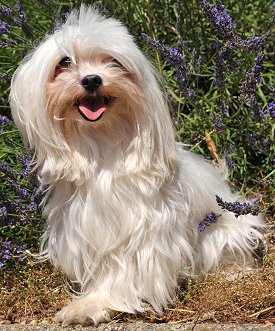Havanese
- Group 9: Companion and Toy Dogs
- Section 1 Bichons and related breeds
- Without working trial
Western Mediterranean basin / Cuba
FCI
Havanais Bichon, Bichon Habanero
21-29 cm
The Havanese is a dog breed recognized by the FCI from the Mediterranean and Cuba (FCI Group 9, Section 1.1, Standard No. 250).
Origin and History
This breed comes from the Western Mediterranean region and has developed along the Spanish and Italian coastal region. Seem that these dogs were imported early in Cuba by ocean navigating Italian captains. Meanwhile, all the Havanese in Cuba are extinct; some descendants have survived in the United States.
Today the Havanese in the world is popular, probably because it gives him in contrast to the only other white bred Bichons ( Maltese, Bolognese, Bichon Frise ), in many colors.
Description
The Havanese has ( be tolerated 21 to 29 cm) at the withers 23-27 cm. The weight is very different and can range from 3 to 4 kg to 8-9 kg. The topcoat is very long (12 to 18 cm in an adult dog), soft, flat or wavy and may form curly strands. It has hardly any undercoat; a hair change between winter and summer coat does not occur. The color is rarely completely pure white; fawn in its different shades from light fawn to havanafarben ( tobacco color, reddish brown ); mottled in these colors allowed; easy black overlay allowed. The slightly cusped drop ears are relatively high, not lying and densely covered with long fringes. The tail is carried high, rolled up either in the form of a crozier or preferably, over the back.
Nature
The Havanese is a good apartment dog, but needs sufficient employment. It goes well with single seniors, but it is rather a whole family, where he can be at the center. It adapts to his family. It is lively, cheerful, affectionate, cuddly and loves to play with children. The lush silky coat often needs to be brushed and combed, so it does not matted.










